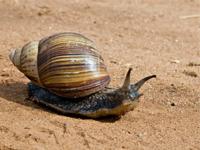
Large shell, brown with darker bands running down the spiral, from 7cms to 20cms in length.
This snail is a hermaphrodite which means each one carries both eggs and sperm, but they need to mate with each other to fertilise their eggs. This species can reproduce very quickly -up to 200 eggs are laid in damp places five or six times a year.
A. fulica moves along on a single foot, driven by waves of muscle contraction in the sole of the foot. A gland at the front of the foot produces slime for the foot to slide over. Teeth are carried on a flexible strap in the mouth (called a radula), that is used like a file, grinding away at the plants they feed on. These snails are active mainly at night. During the day, they shelter from the tropical sun under stones or leaves. Those that do not find shelter before sunrise overheat and die. Their dried out empty shells are a common sight in lawns and gardens. Also called the East African Land Snail, (the species originally came from East Africa - Kenya, Tanzania - where it is also used as a food source) but has been introduced by all over the world, becoming a serious pest. It breeds rapidly, carries a number of parasites harmful to humans, out-competes native species of snails and reaches such large numbers that other predatory species of snail, such as Euglandina rosea, have been disastrously introduced in some areas to control them (in Polynesia, Euglandina has caused the extinction of dozens of native species of tree snail). The snail is a herbivore and its pest status also comes from the fact that it causes serious damage to plants in gardens and nurseries.